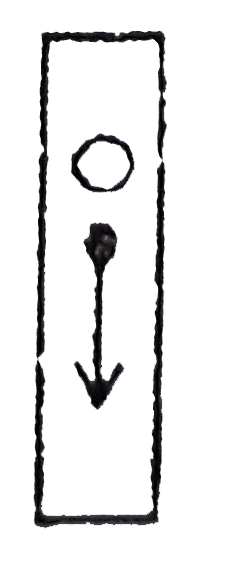(a) A rod of length is moved horizontally with a uniform velocity 'v' in a direction perpendicular to its length through a region in which a uniform magnetic field is acting vertically downward. Derive the exprwession for the emf induced across the ends of the rod. (b) How does one understand this motional emf by invoking the Lorentz force on the free charge carries of the condutor ? Explain.
The conductor is moving in a direction perpendicular to the field with constant velocity under the influence of some external agent.
The electrons in the conductor experience a force
→F=q(→v×→B)
That is directed along the length l perpendicular to both v to B
Under the influence of this force, the electrons move to the lower end of the conduction and accumulate there leaving a net positive charge at the upper end.As a result of this charge separation an electric field is product inside the conductor.The charges accumulate at both ends until the downward magnetic force qvB is balanced by the upward electric force qE.At this point, electrons stop moving .The condition of equilibrium requires that
q[→E+(→v×→B)]=0
→E=−(→v×→B)
V=−∫→E.d→l
ΔV=(→v×→B).→l
=V⊥l⊥v
B⊥ is the component of magnetic field perpendicular to the velocity.
(a)ϕB=Blx
ε=−dϕBdt=−ddt(Blx)
ε=Blv



Topper's Solved these Questions
- ELECTROMAGNETIC INDUCTIONBook:RESONANCEChapter:ELECTROMAGNETIC INDUCTIONExercise:A.l.P
Explore 19 Videos
- ELECTROMAGNETIC INDUCTIONBook:RESONANCEChapter:ELECTROMAGNETIC INDUCTIONExercise:Exercis-3 PART 2
Explore 16 Videos
- ELECTRODYNAMICSBook:RESONANCEChapter:ELECTRODYNAMICSExercise:Advanced level problems
Explore 31 Videos
- ELECTROSTATICSBook:RESONANCEChapter:ELECTROSTATICSExercise:HLP
Explore 39 Videos
Similar Questions
A conducting rod of unit length moves with a velocity of 5m/s in a direction perpendicular to its length and perpendicular to a uniform magnetic field of magnitude 0.4T. Find the emf induced between the ends of the stick.
View SolutionA metallic wire PQ of length 1 cm moves with a velocity of 2m/s in a direction perpendicular to its length and perpendicular to a uniform magnetic field of magnitude 0.2 T. Find the emf induced between the ends of the wire. Which end will be positively charged.

View Solution
Knowledge Check
A metallic meter stick moves with a velocity of 2m/sec in a diretion perpendicular to its length and perpendicular to a uniform magnetic firld of magnitude 0.2T . The emf induced between the ends of the stick
A0.2VB0.4VC0.5VD0.6VA small conducting rod of length l, moves with a uniform velocity v in a uniform magnetic field B as shown in fig __
 AThen the end X of the rod becomes positively chargedBThe end Y of the rod becomes positively chargedCThe entire rod is unevenly chargedDThe rod becomes hot due to joule heating
AThen the end X of the rod becomes positively chargedBThe end Y of the rod becomes positively chargedCThe entire rod is unevenly chargedDThe rod becomes hot due to joule heatingA metal rod moves at a constant velocity in a direction perpendicular to its length. A constant, uniform magnetic field exists in space in a direction perpendicular to the rod as well as its velocity. Select the correct statements(s) from the following
AThe entire rod is at the same electric potential.BThere is an electric field in the rod.CThe electric potential is highest at the centre of the rod and decreases towards its ends.DThe electric potential is lowest at the centre of the rod, and increases towards its ends.
A metallic metre sitck moves with a velocity of 2 ms ^(-1) in a direction perpendicular to its length and perpendicular to a uniform magnetic field of magnitude 0.2 T. Find the emf indcued between the ends of the stick.
View SolutionA metallic wire PQ of length 1cm moves with a velocity of 2m/s in a direction perpendicular to its length and perpendicular to a uniform magnetic field of magnitude 0.2T.Find the emf induced between the ends of the wire.Which end will be positively charged.

View SolutionA rod of length l rotates with a small but uniform angular velocity ω about its perpendicular bisector. A uniform magnetic field B exists parallel to the axis of rotation. The potential difference between the centre of the rod and an end is
View SolutionA metallic rod of length l is moved perpendicular to its length with velocity v in a magnetic field →B acting perpendicular to the plane in which rod moves. Derive the expression for the induced emf. Or Starting from the expression for the Lorentz force acting on the free charge carriers of a conductor moving in a perpef Zicular magnetic field, obtain the expression for the motional emf induced.
View SolutionA rod of length l rotates with a uniform angular velocity omega about its perpendicular bisector. A uniform magnetic field B exists parallel to the axis of rotation. The potential difference between the two ends of the rod is
View Solution